Tensile Behavior Assessment of Grid-Type CFRP Textile-Reinforced Mortar with Different Design Variables
Abstract
1. Introduction
2. Materials and Methods
2.1. Materials and Specimens
2.2. Test Methods
3. Results and Discussion
3.1. Crack Pattern and Failure Mode
3.2. Tensile Stress–Strain Relationship
3.3. Effect of CFRP Grid Characteristics on Bond Strengths
4. Conclusions
- The direct tensile test results of TRM specimens revealed that, as cracks developed, the load shifted to the longitudinal strands of the CFRP grid, resulting in decreased stiffness until reaching the ultimate strength. Crack locations within the mortar matrix varied depending on specimen length and carbon textile type. Across most TRM specimens, once the ultimate strength was reached, a sharp decline was observed in load, coinciding with strand rupture. By contrast, specimens experiencing stress reduction from slippage between the clamping steel plate and TRM specimens showed a gradual load decrease after the ultimate strength. This was due to incomplete load transfer caused by clamping area slip, leading to an underestimation of the ultimate strength.
- Increasing the number of longitudinal CFRP strands in TRM specimens’ cross sections effectively enhanced the ultimate strength up to 64.4% and crack control. Cracks uniformly appeared within the TRM specimen’s measurement range at intervals akin to the strands. As the strand spacing expanded, the average crack spacing also increased. When a sufficient number of strands are present within the TRM specimen, the consistency of the test is not significantly compromised, even with a shorter width-to-length ratio.
- The strength of the mortar matrix significantly influenced the cracking strength of the TRM specimens more than their ultimate strength up to 27.4%. Changes in the transverse strands due to variations in the measuring net length of TRM specimens did not notably contribute to crack suppression but influenced the control over cracking space. Hence, effective evaluation of TRM specimen tensile performance appears achievable when the ratio of measuring net length to TRM width is relatively small (at least 2:1).
- The surface coating of the CFRP grid is pivotal in determining the tensile strength and crack properties of TRM specimens. Sand coating notably enhanced the ultimate strength of TRM specimens by over 40% and effectively doubled the number of cracks compared with untreated specimens, leading to densely distributed cracks. Moreover, the sand coating on the CFRP grid surface improved interfacial bond performance between the CFRP grid and the mortar matrix by 2.2–2.8 times. This surface treatment introduced interlocking elements on the CFRP grid within TRM specimens, thereby enhancing interfacial bond performance as the mortar matrix strength increased.
- TRM specimens incorporating CFRP grid KC with an adhesive structure did not exhibit optimal bond performance, thus failing to fully demonstrate its tensile potential. However, they showed relatively high tensile strength and similar failure modes compared with TRM specimens using other biaxial-warp-knitting-structure CFRP grids. Therefore, CFRP grid KC appears suitable for TRM applications. Future studies should focus on enhancing bond strength within the mortar matrix through coating applications, optimizing the grid width and cross-sectional shape, and exploring various other variables to further improve the tensile performance of TRM using CFRP grid KC.
Author Contributions
Funding
Institutional Review Board Statement
Informed Consent Statement
Data Availability Statement
Acknowledgments
Conflicts of Interest
References
- Cabrera, J.G. Deterioration of concrete due to reinforcement steel corrosion. Cem. Concr. Compos. 1996, 18, 47–59. [Google Scholar] [CrossRef]
- Mehta, P.K.; Monteiro, P.J.M. Concrete: Microstructure, Properties, and Materials; McGraw-Hill Publishing: New York, NY, USA, 2006; p. 659. [Google Scholar]
- Mansur de Castro Silva, R.; de Andrade Silva, F. Carbon textile reinforced concrete: Materials and structural analysis. Mater. Struct. 2020, 53, 17. [Google Scholar] [CrossRef]
- Sheikh, S.A.; Kharal, Z. Replacement of steel with GFRP for sustainable reinforced concrete. Constr. Build. Mater. 2018, 160, 767–774. [Google Scholar] [CrossRef]
- D’Antino, T.; Papanicolaou, C. Mechanical characterization of textile reinforced inorganic-matrix composites. Compos. Part B Eng. 2017, 127, 78–91. [Google Scholar] [CrossRef]
- Hartig, J.; Jesse, F.; Schicktanz, K.; Häußler-Combe, U. Influence of experimental setups on the apparent uniaxial tensile load-bearing capacity of Textile Reinforced Concrete specimens. Mater. Struct. 2012, 45, 433–446. [Google Scholar] [CrossRef]
- Raoof, S.M.; Koutas, L.N.; Bournas, D.A. Textile-reinforced mortar (TRM) versus fibre-reinforced polymers (FRP) in flexural strengthening of RC beams. Constr. Build. Mater. 2017, 151, 279–291. [Google Scholar] [CrossRef]
- María, R.-M.; Paula, V.-L.; Jaime, F.-G.; Jorge, L.R. Improvement of tensile properties of carbon fibre-reinforced cementitious matrix composites with coated textile and enhanced mortars. Constr. Build. Mater. 2023, 369, 130552. [Google Scholar] [CrossRef]
- ACI 224R-01; ACI Committee 224. Control of Cracking in Concrete Structure. American Concrete Institute: Indianapolis, IN, USA, 2001.
- Naser, M.Z.; Hawileh, R.A.; Abdalla, J.A. Fiber-reinforced polymer composites in strengthening reinforced concrete structures: A critical review. Eng. Struct. 2019, 198, 109542. [Google Scholar] [CrossRef]
- Zhao, C.; Wang, Z.; Zhu, Z.; Guo, Q.; Wu, X.; Zhao, R. Research on different types of fiber reinforced concrete in recent years: An overview. Constr. Build. Mater. 2023, 365, 130075. [Google Scholar] [CrossRef]
- Kouris, L.A.S.; Triantafillou, T.C. State-of-the-art on strengthening of masonry structures with textile reinforced mortar (TRM). Constr. Build. Mater. 2018, 188, 1221–1233. [Google Scholar] [CrossRef]
- Williams Portal, N.; Flansbjer, M.; Zandi, K.; Wlasak, L.; Malaga, K. Bending behaviour of novel Textile Reinforced Concrete-foamed concrete (TRC-FC) sandwich elements. Compos. Struct. 2017, 177, 104–118. [Google Scholar] [CrossRef]
- Carozzi, F.G.; Bellini, A.; D’Antino, T.; de Felice, G.; Focacci, F.; Hojdys, Ł.; Laghi, L.; Lanoye, E.; Micelli, F.; Panizza, M.; et al. Experimental investigation of tensile and bond properties of Carbon-FRCM composites for strengthening masonry elements. Compos. Part B Eng. 2017, 128, 100–119. [Google Scholar] [CrossRef]
- Kim, H.-S.; Truong, G.T.T.T.; Park, S.-H.; Choi, K.-K. Tensile Properties of Carbon Fiber-Textile Reinforced Mortar (TRM) Characterized by Different Anchorage Methods. Int. J. Concr. Struct. Mater. 2018, 12, 977–989. [Google Scholar] [CrossRef]
- Pham, H.H.; Dinh, N.H.; Kim, S.-H.; Park, S.-H.; Choi, K.-K. Tensile behavioral characteristics of lightweight carbon textile-reinforced cementitious composites. J. Build. Eng. 2022, 57, 104848. [Google Scholar] [CrossRef]
- Trung Duc Pham, L.; Woo, U.; Choi, K.-K.; Choi, H. Tensile characteristics of carbon textile-reinforced mortar incorporating short amorphous metallic and nylon fibers under designed environmental conditions. Constr. Build. Mater. 2022, 352, 129059. [Google Scholar] [CrossRef]
- Pham, H.H.; Dinh, N.H.; Choi, K.-K. Tensile behavior of lightweight carbon textile-reinforced cementitious composites with dispersed fibers. Constr. Build. Mater. 2023, 384, 131455. [Google Scholar] [CrossRef]
- Kim, K.-M.; Cheon, J.-H. Flexural Behavior of One-Way Slab Reinforced with Grid-Type Carbon Fiber Reinforced Plastics of Various Geometric and Physical Properties. Appl. Sci. 2022, 12, 12491. [Google Scholar] [CrossRef]
- Koutas, L.N.; Bournas, D.A. Flexural Strengthening of Two-Way RC Slabs with Textile-Reinforced Mortar: Experimental Investigation and Design Equations. J. Compos. Constr. 2017, 21, 04016065. [Google Scholar] [CrossRef]
- Goliath, K.B.; Cardoso, D.C.T.; de Silva, F.A. Flexural behavior of carbon-textile-reinforced concrete I-section beams. Compos. Struct. 2021, 260, 113540. [Google Scholar] [CrossRef]
- Zhang, B.; Masmoudi, R.; Benmokrane, B. Behaviour of one-way concrete slabs reinforced with CFRP grid reinforcements. Constr. Build. Mater. 2004, 18, 625–635. [Google Scholar] [CrossRef]
- Raoof, S.M.; Koutas, L.N.; Bournas, D.A. Bond between textile-reinforced mortar (TRM) and concrete substrates: Experimental investigation. Compos. Part B Eng. 2016, 98, 350–361. [Google Scholar] [CrossRef]
- Wang, F.; Kyriakides, N.; Chrysostomou, C.; Eleftheriou, E.; Votsis, R.; Illampas, R. Experimental Research on Bond Behaviour of Fabric Reinforced Cementitious Matrix Composites for Retrofitting Masonry Walls. Int. J. Concr. Struct. Mater. 2021, 15, 22. [Google Scholar] [CrossRef]
- Wu, Z.; Deng, M.; Tian, T.; Dong, Z.; Sun, Y.; Zhang, W. Influence of textile grid forms on tensile mechanical behaviors of carbon textile-reinforced composites with polyethylene (PE) short fibers. Arch. Civ. Mech. Eng. 2023, 23, 103. [Google Scholar] [CrossRef]
- Lee, S.; Kim, G.; Kim, H.; Son, M.; Choe, G.; Kobayashi, K.; Nam, J. Impact resistance, flexural and tensile properties of amorphous metallic fiber-reinforced cementitious composites according to fiber length. Constr. Build. Mater. 2021, 271, 121872. [Google Scholar] [CrossRef]
- Deng, M.; Dong, Z.; Zhang, C. Experimental investigation on tensile behavior of carbon textile reinforced mortar (TRM) added with short polyvinyl alcohol (PVA) fibers. Constr. Build. Mater. 2020, 235, 117801. [Google Scholar] [CrossRef]
- Donnini, J.; Corinaldesi, V.; Nanni, A. Mechanical properties of FRCM using carbon fabrics with different coating treatments. Compos. Part B Eng. 2016, 88, 220–228. [Google Scholar] [CrossRef]
- Signorini, C.; Nobili, A.; Cedillo González, E.I.; Siligardi, C. Silica coating for interphase bond enhancement of carbon and AR-glass Textile Reinforced Mortar (TRM). Compos. Part B Eng. 2018, 141, 191–202. [Google Scholar] [CrossRef]
- ICC Evaluation Service. AC434—Masonry and Concrete Strengthening Using Fabric-reinforced Cementitious Matrix (FRCM) and Steel Reinforced Grout (SRG) Composite Systems; ICC Evaluation Service: Brea, CA, USA, 2011. [Google Scholar]
- RILEM Technical Committee 232-TDT. Recommendation of RILEM TC 232-TDT: Test methods and design of textile reinforced concrete. Mater. Struct. 2016, 49, 4923–4927. [Google Scholar] [CrossRef]
- ACI 549.4R-20; ACI Committee 549. Guide to Design and Construction of Externally Bonded Fabric-Reinforced Cementitious Matrix and Steel-Reinforced Grout System for Repair and Strengthening of Concrete Structures. American Concrete Institute: Farmington Hills, MI, USA, 2020.
- Min, K.J.; Kim, K.M.; Song, B.K.; Park, S.W. Flexural Behavior of Slabs Reinforced with Grid-Type CFRP Reinforcement Manufactured Using Adhesion. J. Korea Concr. Inst. 2023, 35, 197–206. [Google Scholar] [CrossRef]
- ASTM C305; ASTM International. Standard Practice for Mechanical Mixing of Hydraulic Cement Pastes and Mortars of Plastic Consistency. ASTM International: West Conshohocken, PA, USA, 2014.
- Zhang, W.; Deng, M.; Han, Y.; Li, R.; Yang, S. Uniaxial tensile performance of high ductile fiber-reinforced concrete with built-in basalt textile grids. Constr. Build. Mater. 2022, 315, 125716. [Google Scholar] [CrossRef]
- Leone, M.; Aiello, M.A.; Balsamo, A.; Carozzi, F.G.; Ceroni, F.; Corradi, M.; Gams, M.; Garbin, E.; Gattesco, N.; Krajewski, P.; et al. Glass fabric reinforced cementitious matrix: Tensile properties and bond performance on masonry substrate. Compos. Part B Eng. 2017, 127, 196–214. [Google Scholar] [CrossRef]
- Ferrara, G.; Pepe, M.; Martinelli, E.; Tolêdo Filho, R.D. Tensile behavior of flax textile reinforced lime-mortar: Influence of reinforcement amount and textile impregnation. Cem. Concr. Compos. 2021, 119, 103984. [Google Scholar] [CrossRef]
- Arboleda, D.; Carozzi, F.G.; Nanni, A.; Poggi, C. Testing Procedures for the Uniaxial Tensile Characterization of Fabric-Reinforced Cementitious Matrix Composites. J. Compos. Constr. 2016, 20, 04015063. [Google Scholar] [CrossRef]
- Santis, S.D.; Hadad, H.A.; Basalo, F.D.C.Y.; Felice, G.D.; Nanni, A. Acceptance Criteria for Tensile Characterization of Fabric-Reinforced Cementitious Matrix Systems for Concrete and Masonry Repair. J. Compos. Constr. 2018, 22, 04018048. [Google Scholar] [CrossRef]
- EN 1991; Eurocode 2: Design of Concrete Structures. The European Union: Brussels, Belgium, 2004.
- Frosch, R.J. Another Look at Cracking and Crack Control in Reinforced Concrete. ACI Struct. J. 1999, 96, 437–442. [Google Scholar]
- Mechtcherine, V.; Schneider, K.; Brameshuber, W. 2—Mineral-based matrices for textile-reinforced concrete. In Textile Fibre Composites in Civil Engineering; Triantafillou, T., Ed.; Woodhead Publishing: Cambridge, UK, 2016; pp. 25–43. [Google Scholar]
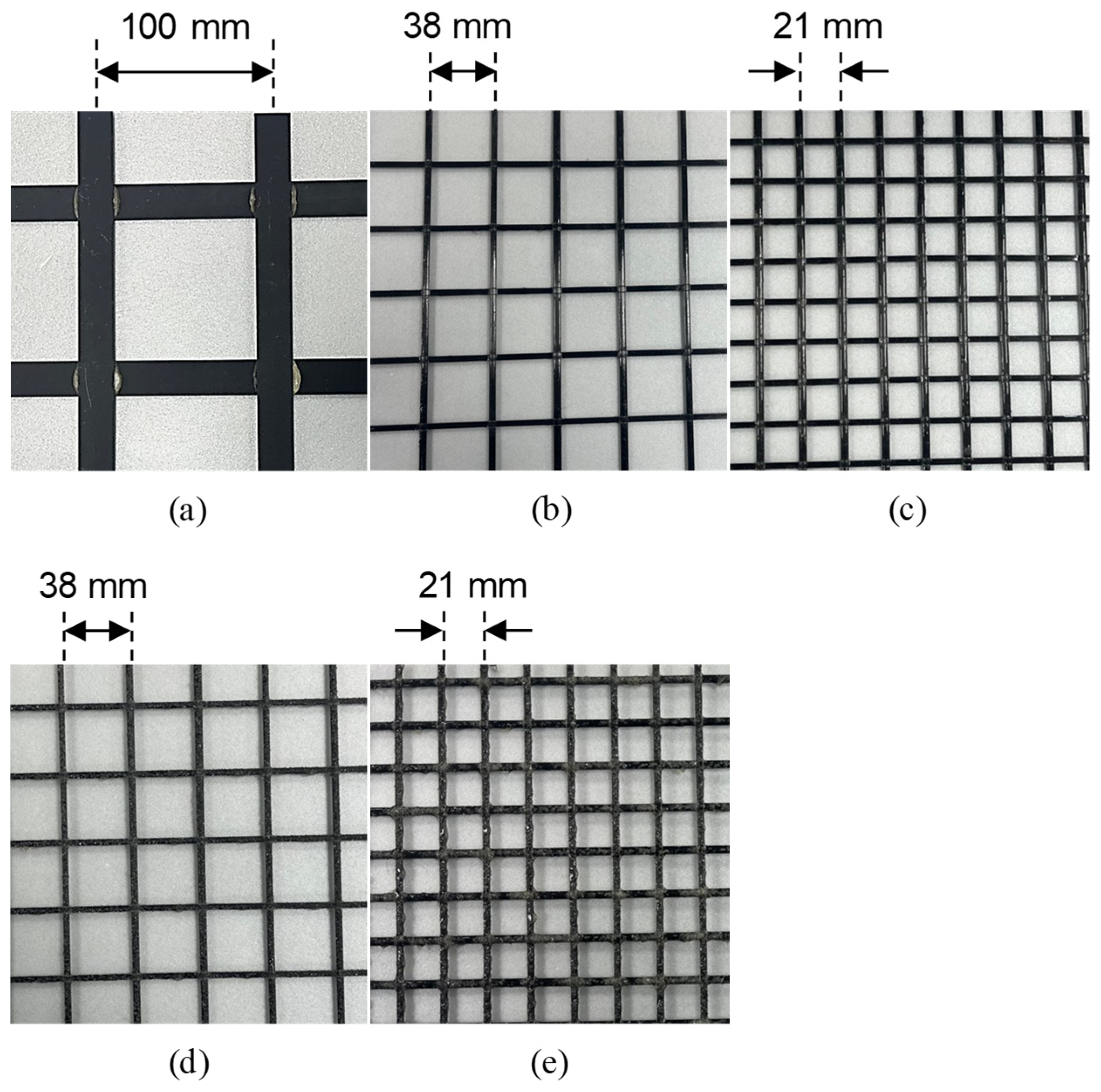
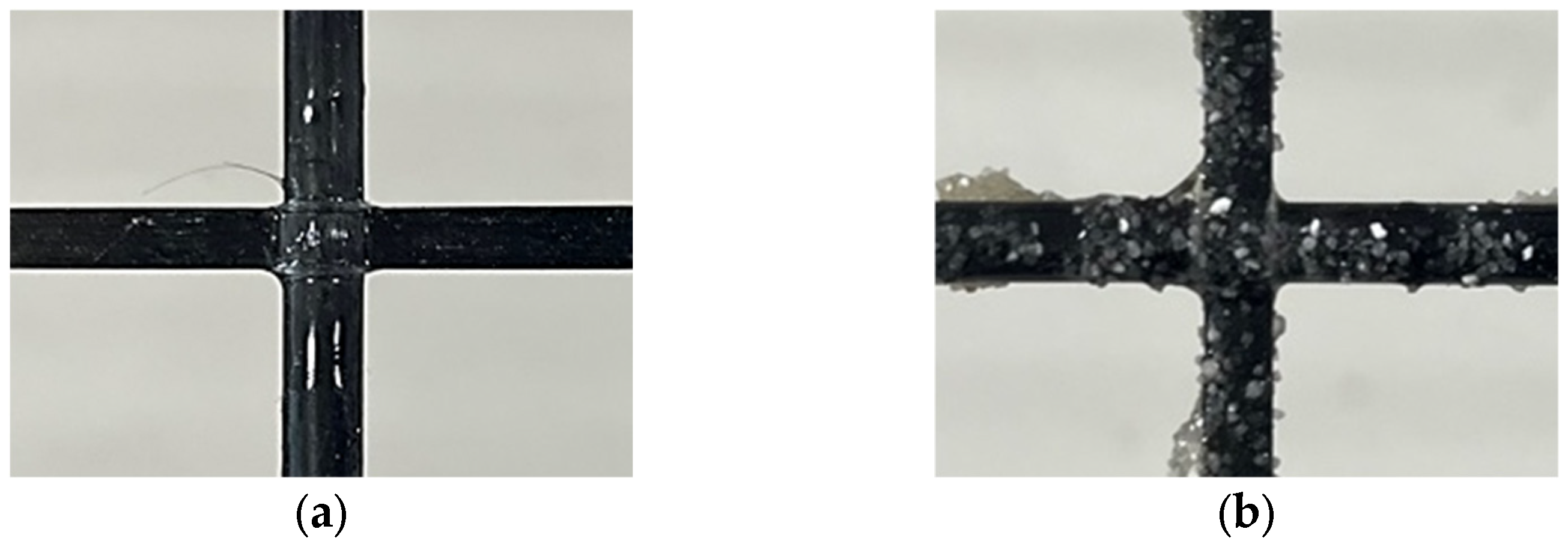
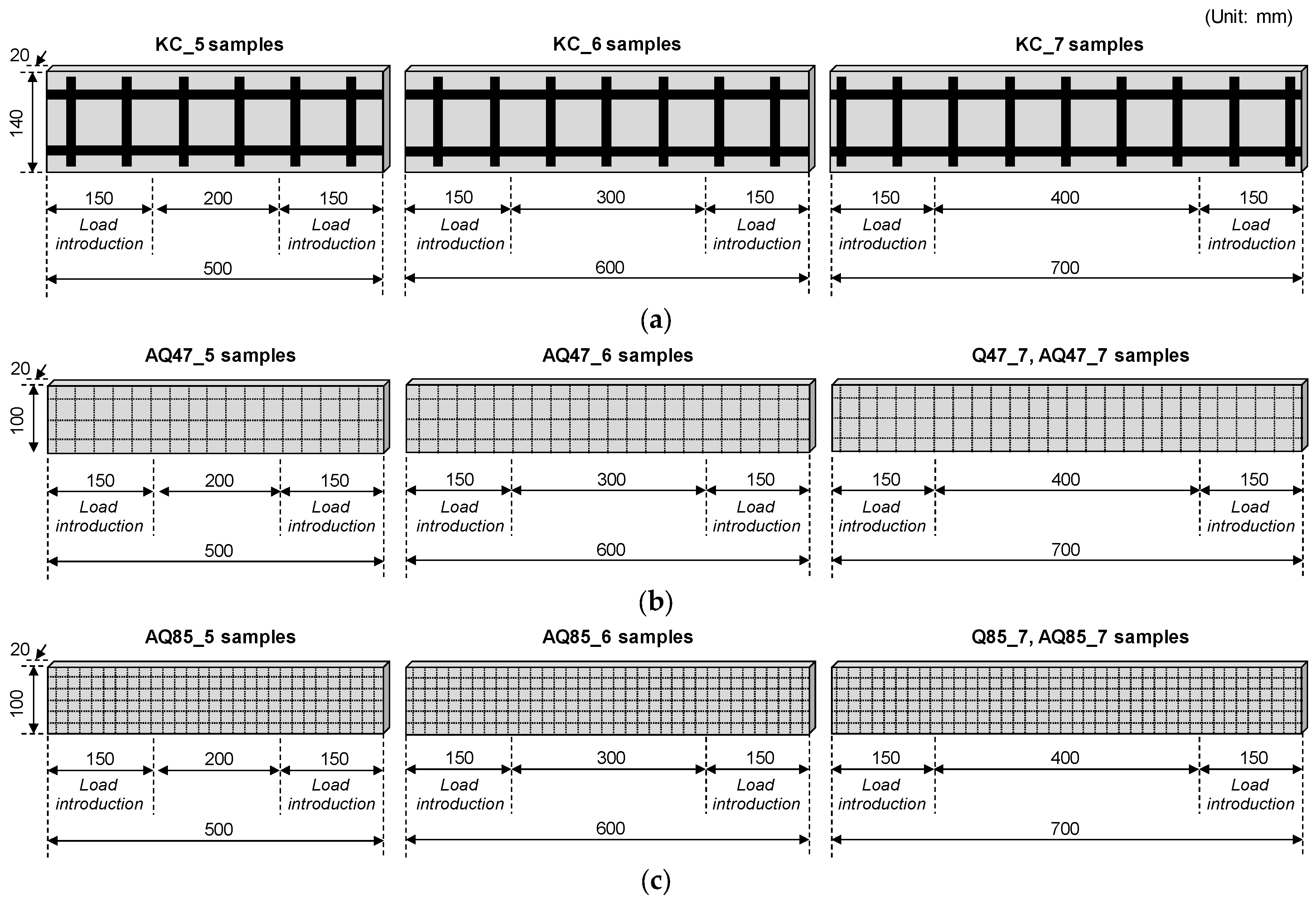
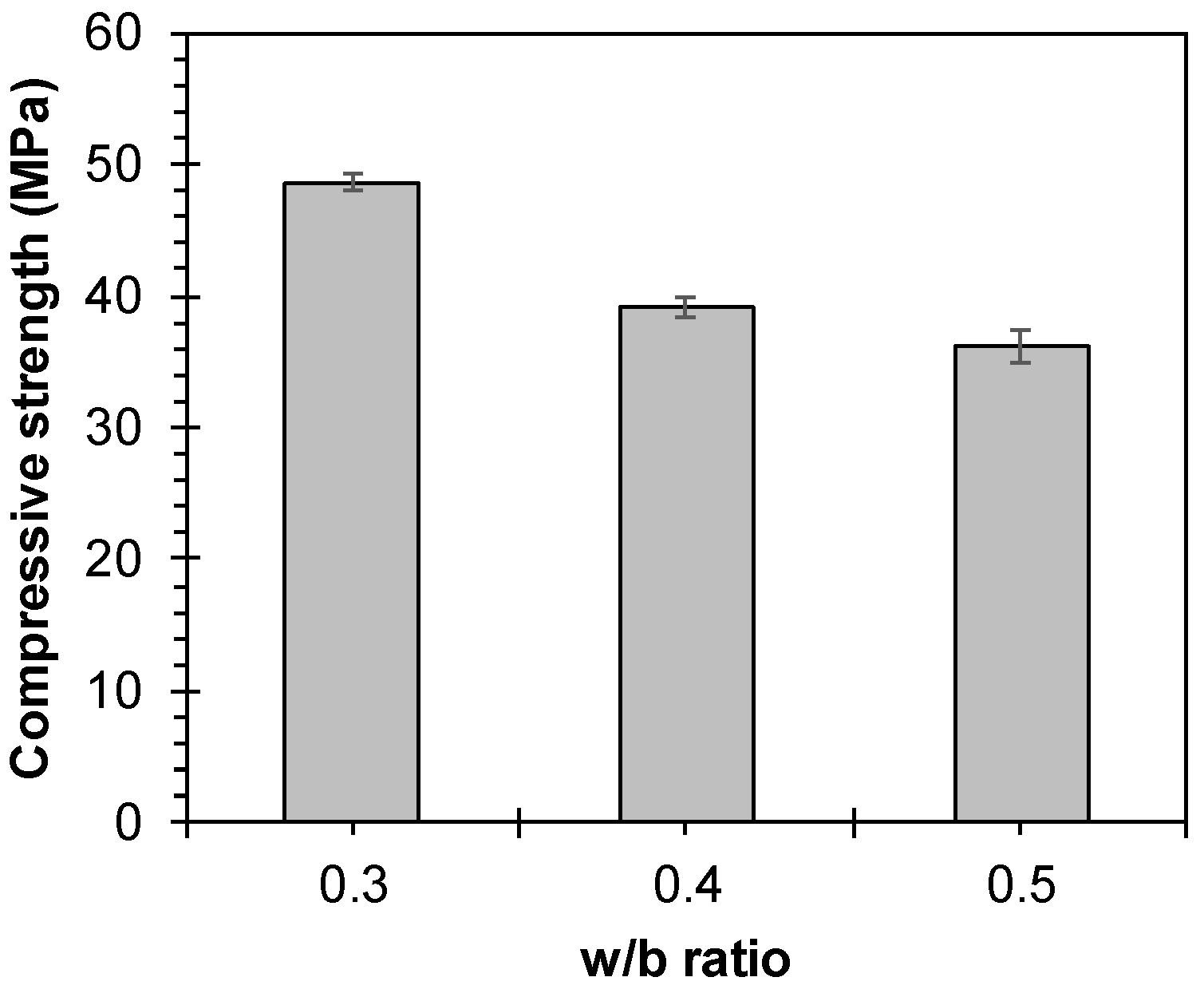

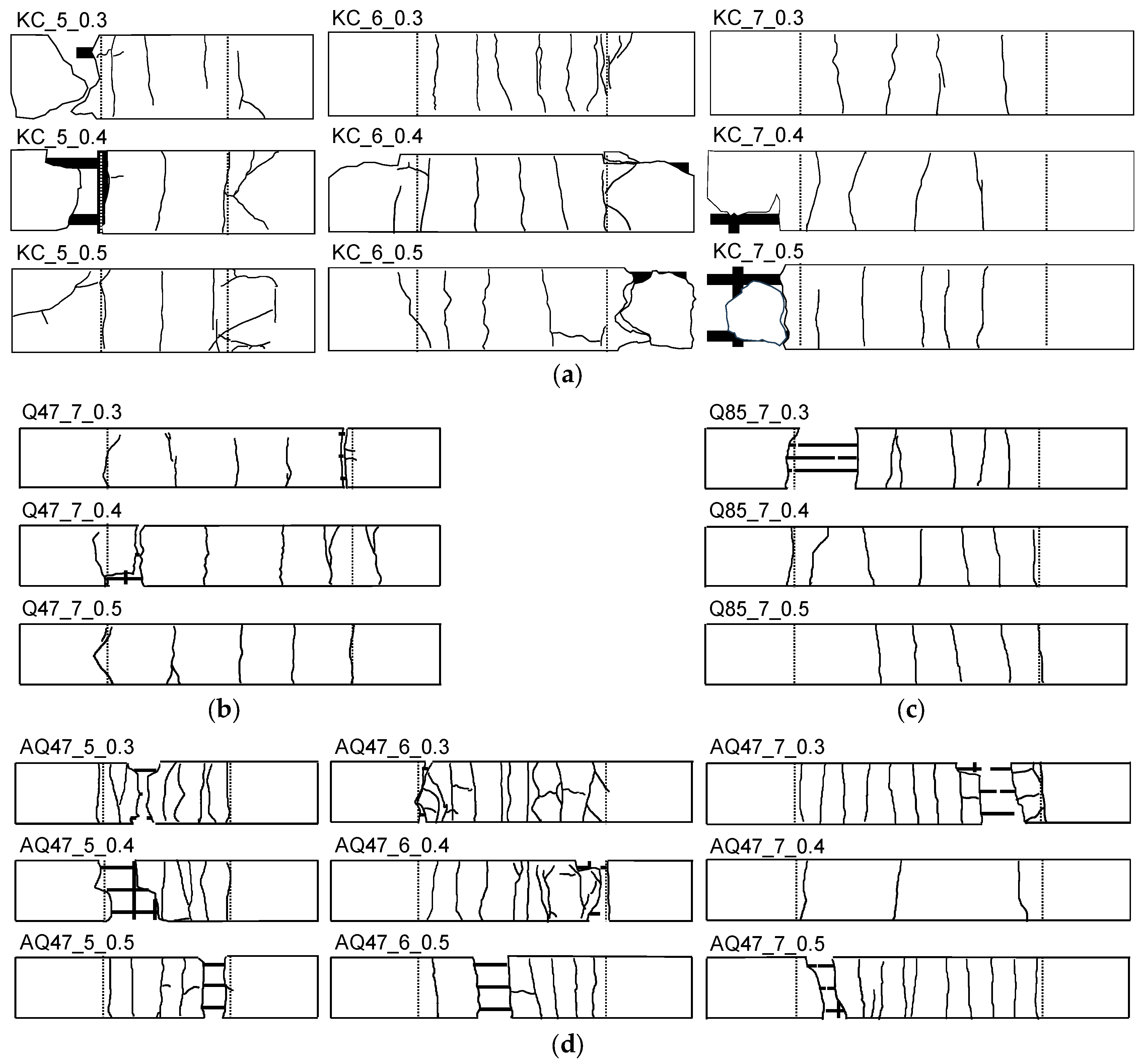

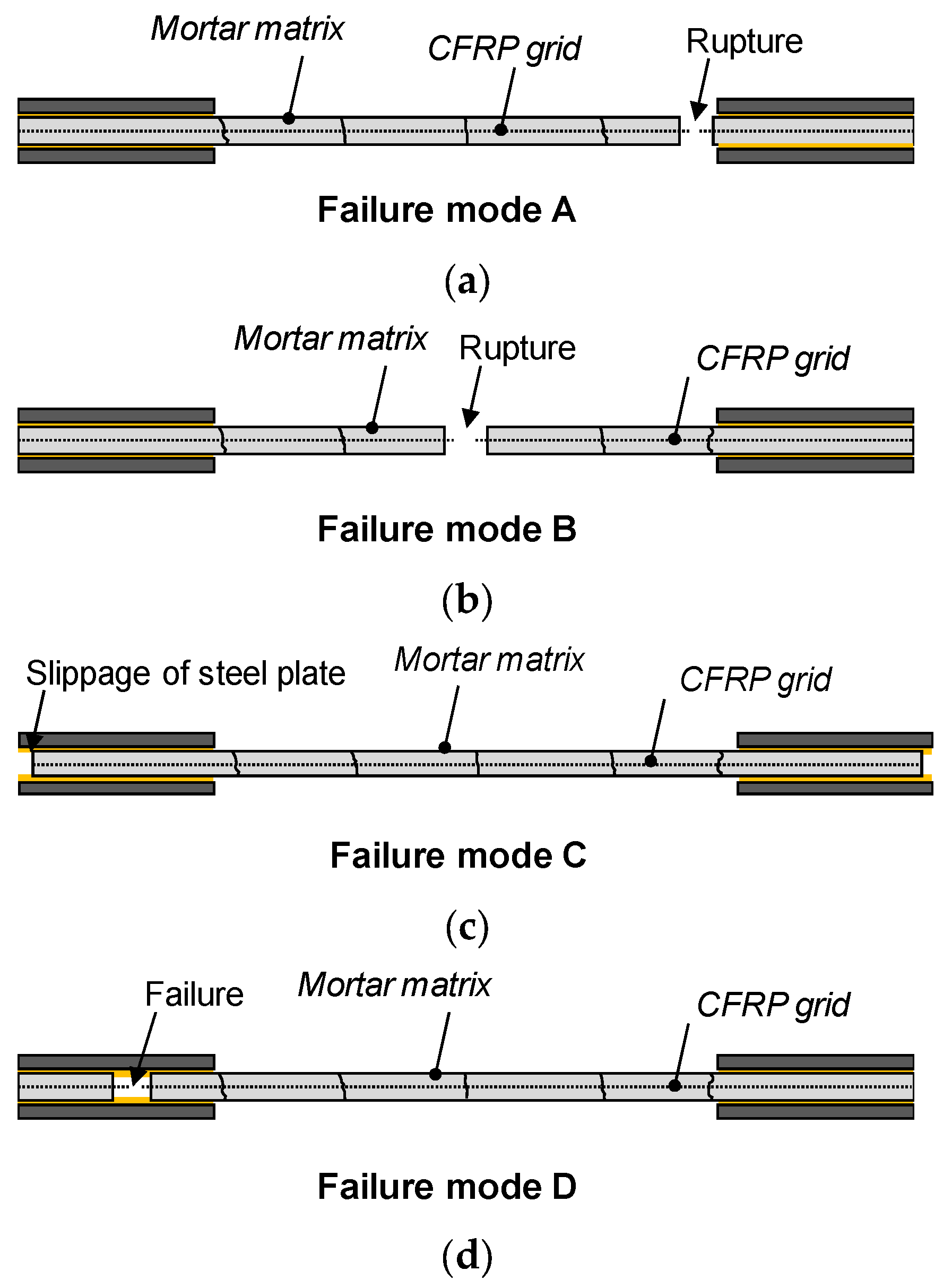

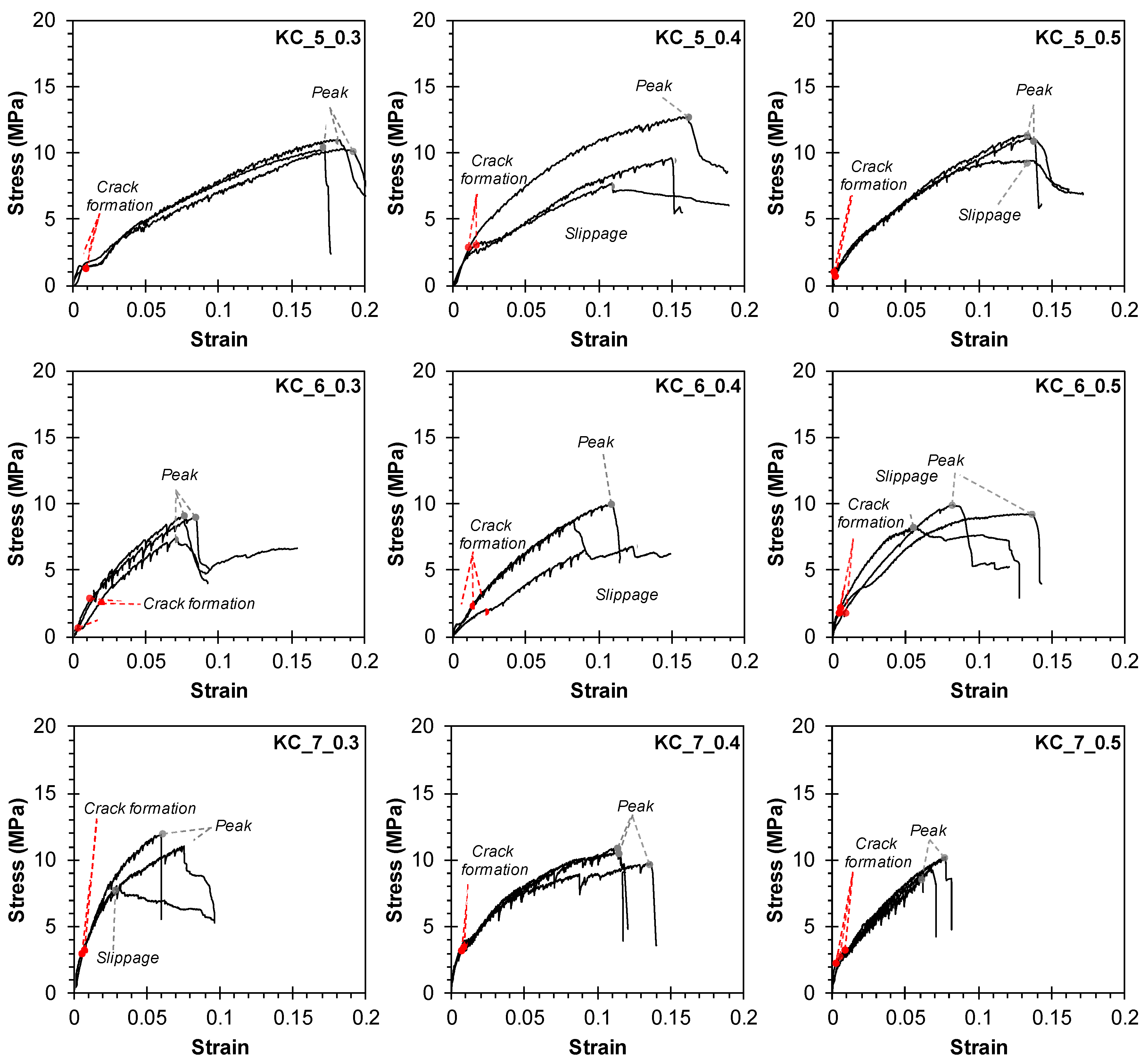
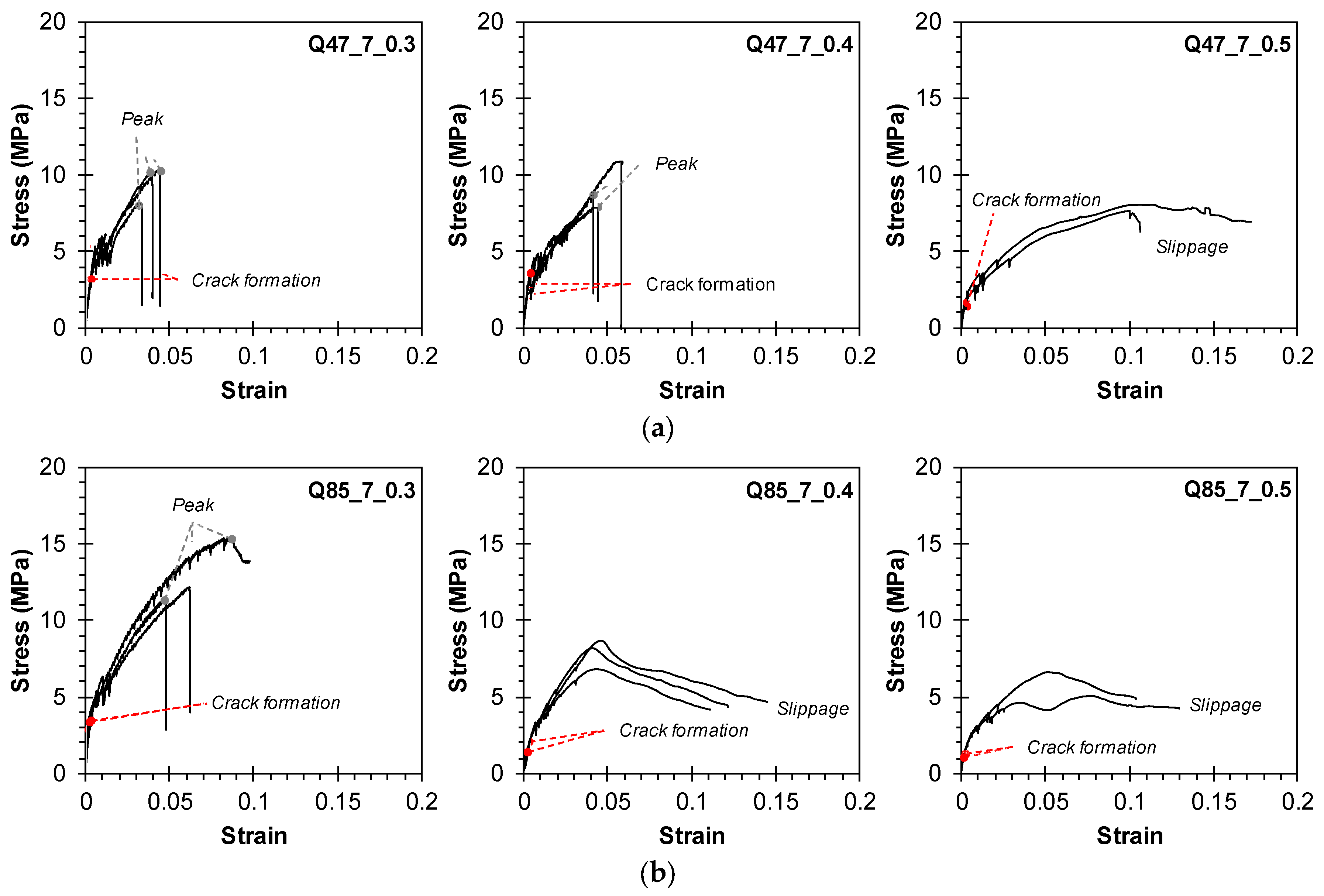
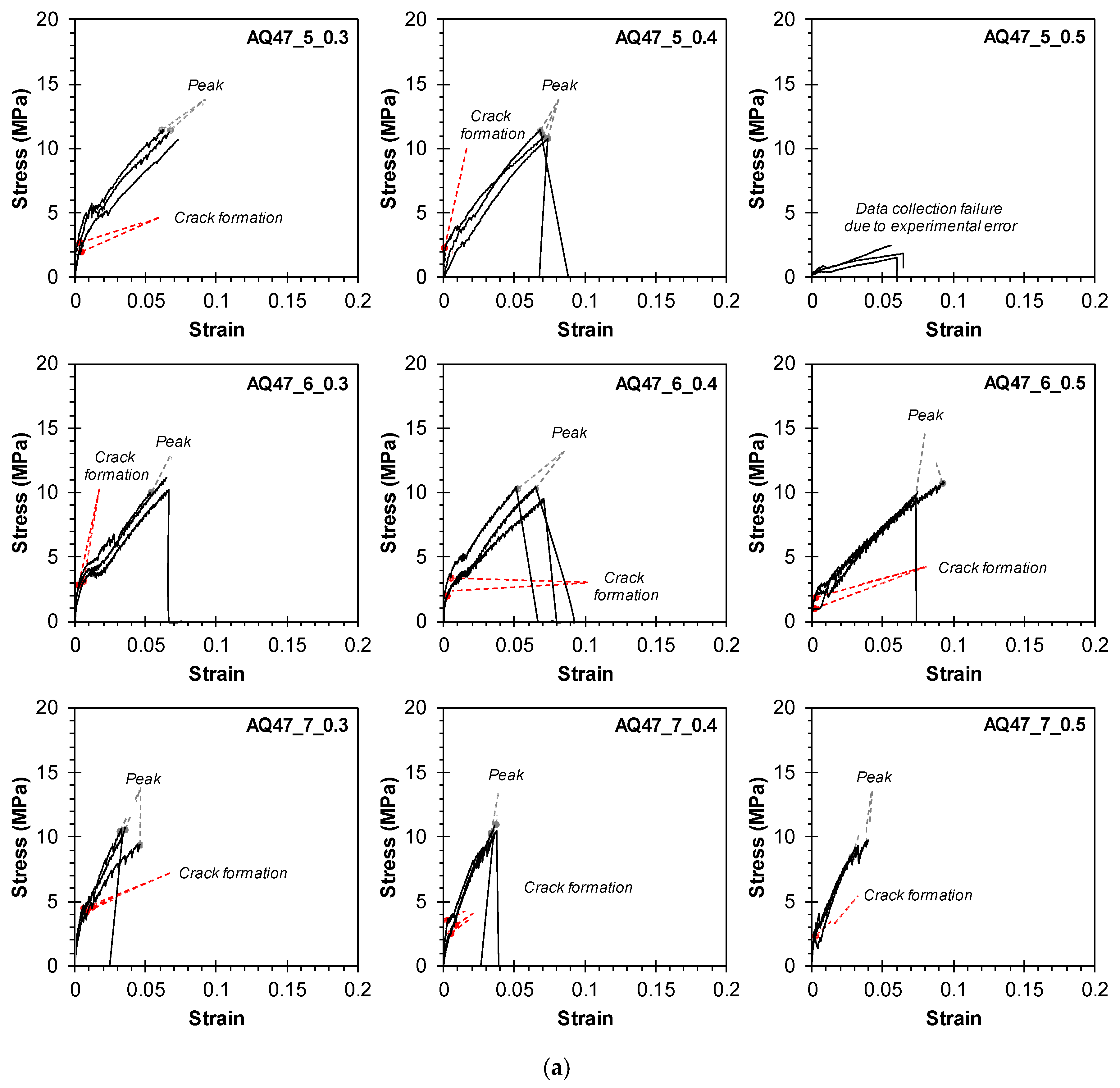
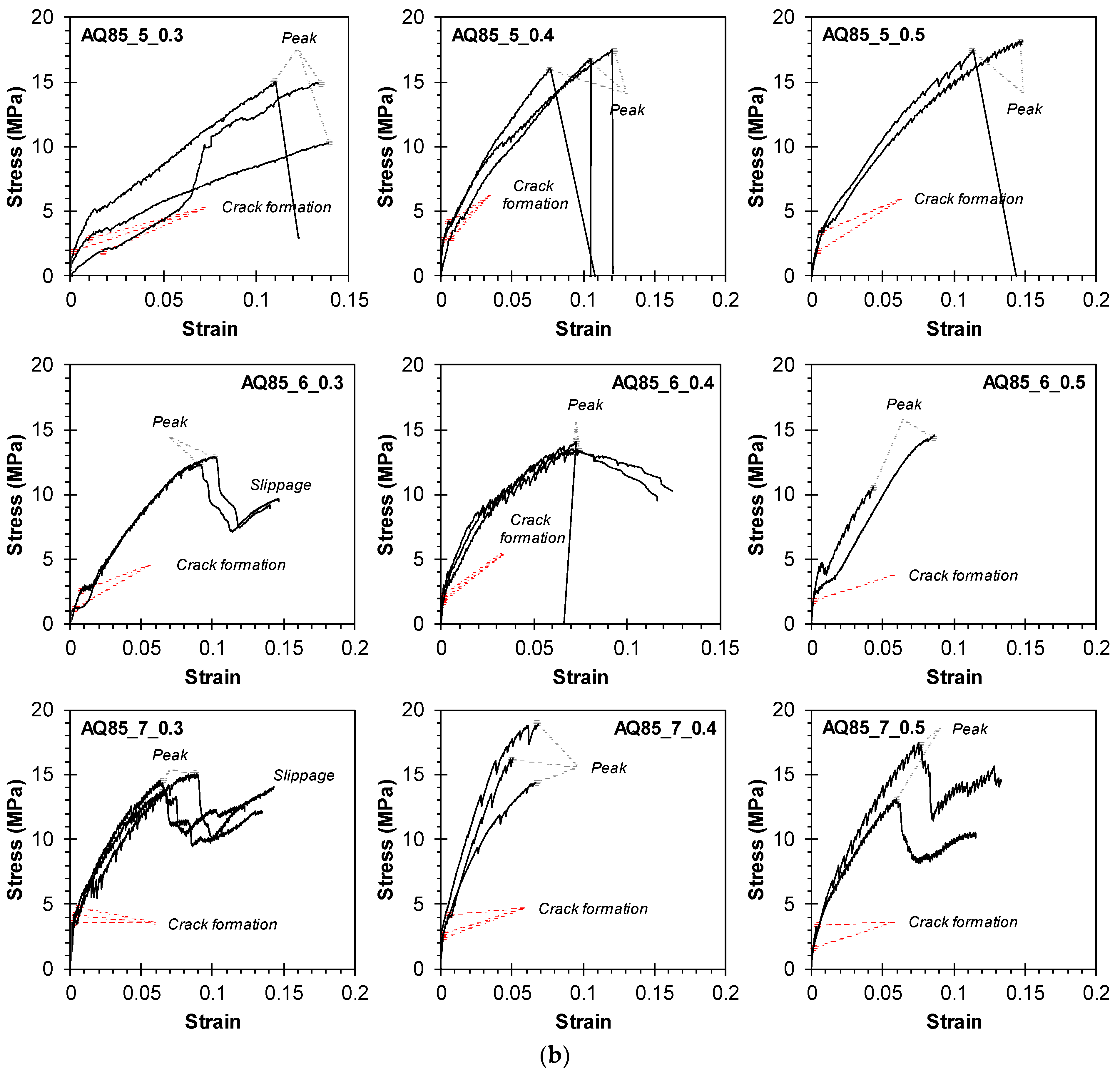


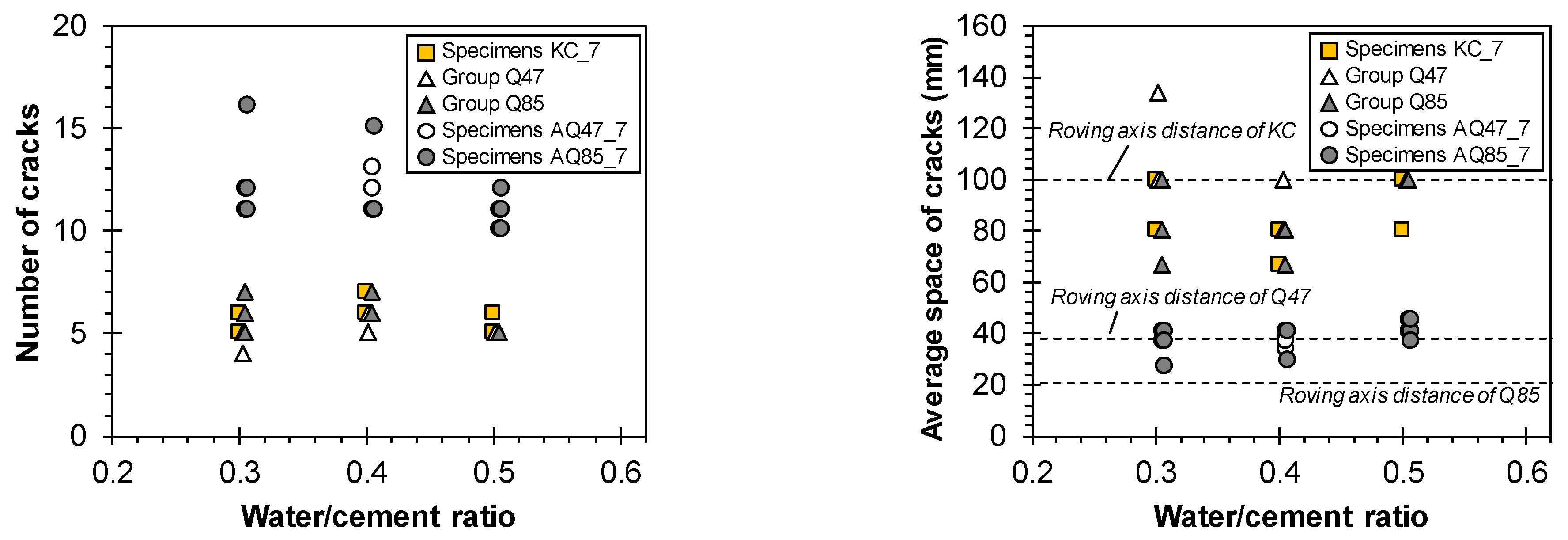
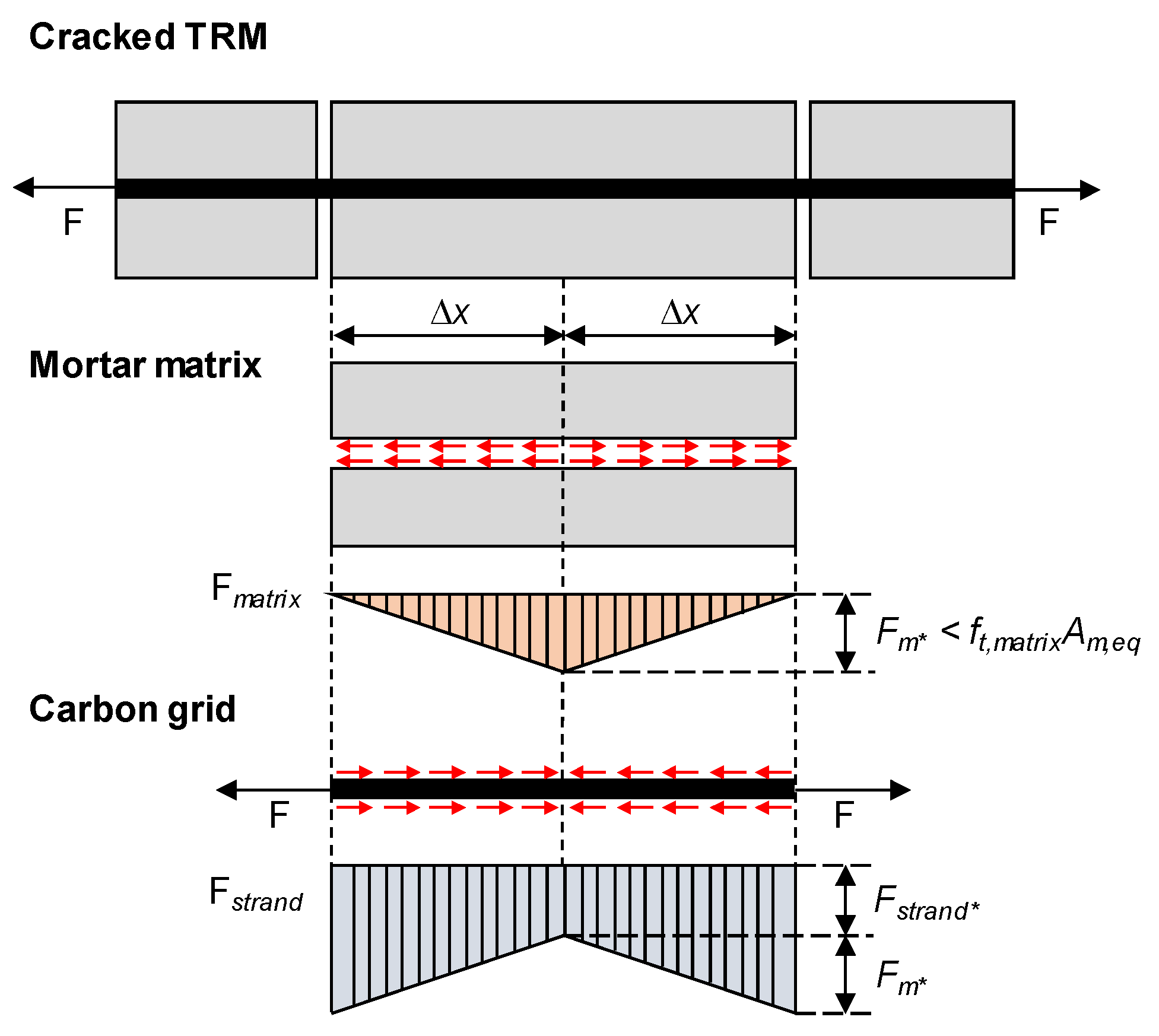
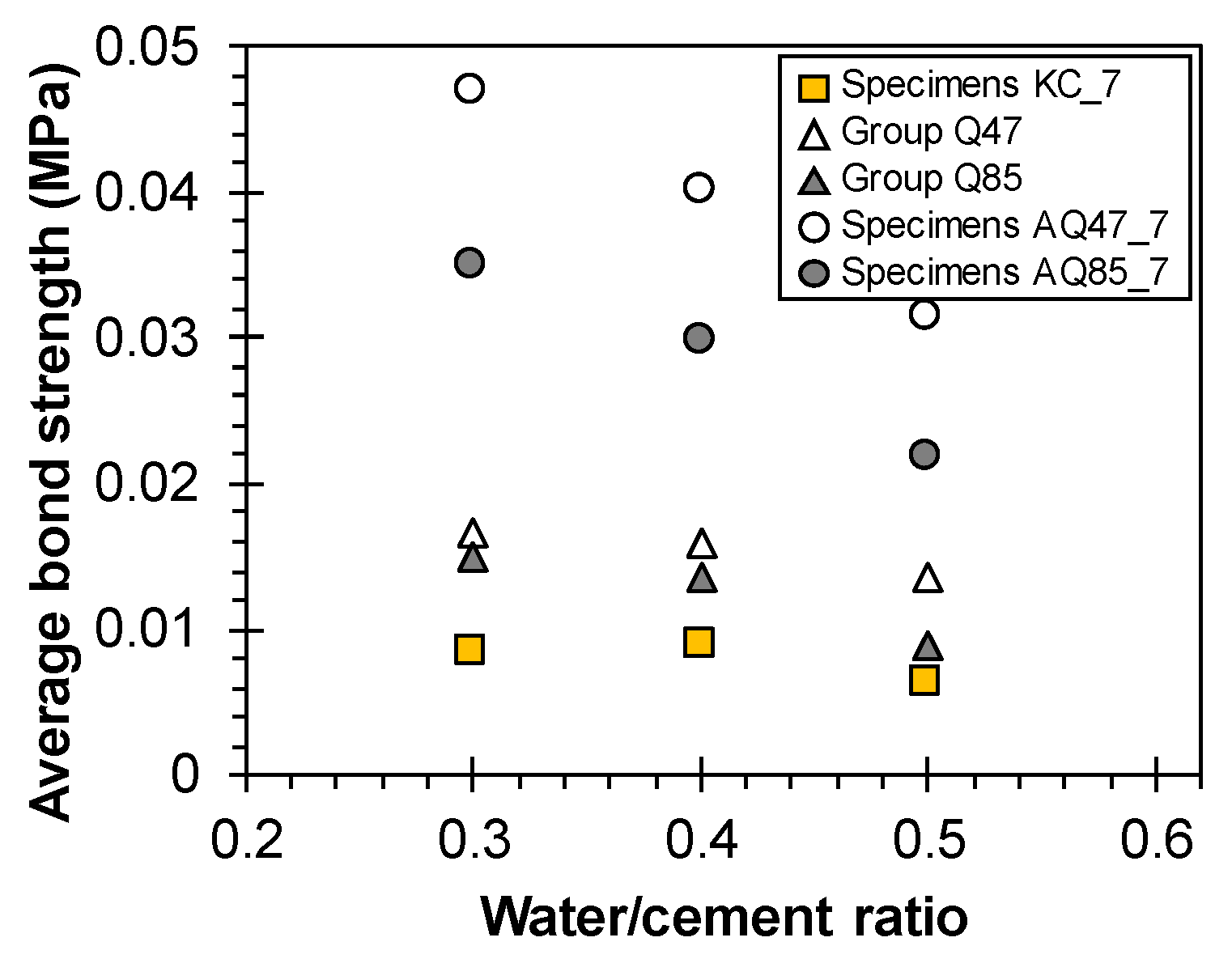
| CFRP Grid | Fiber Material | Structure | Impregnation Material | Surface Treatment | Cross-Sectional Area of Strand (mm2) | Strand Spacing (mm) | Tensile Strength (MPa) | Tensile Modulus of Elasticity (GPa) |
|---|---|---|---|---|---|---|---|---|
| KC | Carbon | Adhesive structure | Epoxy resin | - | 20 | 100 | 2327 | 179 |
| Q47 | Carbon | Biaxial warp knitting structure | Epoxy resin | - | 1.81 | 38 | 4379 | 255 |
| AQ47 | ||||||||
| Q85 | Sand coating | 1.81 | 21 | 4121 | 244 | |||
| AQ85 |
| Group | Specimen | Width (mm) | Thickness (mm) | Length (mm) | Measuring Net Length (mm) | w/c Ratio of Mortar | Number of Longitudinal Strands | Tensile Capacity (kN) |
|---|---|---|---|---|---|---|---|---|
| KC | KC_5_0.3 | 140 | 20 | 500 | 200 | 0.3 | 2 | 93.1 |
| KC_5_0.4 | 0.4 | |||||||
| KC_5_0.5 | 0.5 | |||||||
| KC_6_0.3 | 140 | 20 | 600 | 300 | 0.3 | |||
| KC_6_0.4 | 0.4 | |||||||
| KC_6_0.5 | 0.5 | |||||||
| KC_7_0.3 | 140 | 20 | 700 | 400 | 0.3 | |||
| KC_7_0.4 | 0.4 | |||||||
| KC_7_0.5 | 0.5 | |||||||
| Q47 | Q47_7_0.3 | 100 | 20 | 700 | 400 | 0.3 | 3 | 23.8 |
| Q47_7_0.4 | 0.4 | |||||||
| Q47_7_0.5 | 0.5 | |||||||
| Q85 | Q85_7_0.3 | 100 | 20 | 700 | 400 | 0.3 | 5 | 37.3 |
| Q85_7_0.4 | 0.4 | |||||||
| Q85_7_0.5 | 0.5 | |||||||
| AQ47 | AQ47_5_0.3 | 100 | 20 | 500 | 200 | 0.3 | 3 | 23.8 |
| AQ47_5_0.4 | 0.4 | |||||||
| AQ47_5_0.5 | 0.5 | |||||||
| AQ47_6_0.3 | 100 | 20 | 600 | 300 | 0.3 | |||
| AQ47_6_0.4 | 0.4 | |||||||
| AQ47_6_0.5 | 0.5 | |||||||
| AQ47_7_0.3 | 100 | 20 | 700 | 400 | 0.3 | |||
| AQ47_7_0.4 | 0.4 | |||||||
| AQ47_7_0.5 | 0.5 | |||||||
| AQ85 | AQ85_5_0.3 | 100 | 20 | 500 | 200 | 0.3 | 5 | 37.3 |
| AQ85_5_0.4 | 0.4 | |||||||
| AQ85_5_0.5 | 0.5 | |||||||
| AQ85_6_0.3 | 100 | 20 | 600 | 300 | 0.3 | |||
| AQ85_6_0.4 | 0.4 | |||||||
| AQ85_6_0.5 | 0.5 | |||||||
| AQ85_7_0.3 | 100 | 20 | 700 | 400 | 0.3 | |||
| AQ85_7_0.4 | 0.4 | |||||||
| AQ85_7_0.5 | 0.5 |
| Group | Specimen | Failure Mode (see Figure 7) | Number of Cracks, ncrack | Average Space of Cracks, sm (mm) | ||||
|---|---|---|---|---|---|---|---|---|
| ncrack,1 | ncrack,2 | ncrack,3 | sm,1 | sm,2 | sm,3 | |||
| KC | KC_5_0.3 | C, D | 4 | 3 | 5 | 66.7 | 100.0 | 50.0 |
| KC_5_0.4 | C, D | 4 | 3 | 3 | 66.7 | 100.0 | 100.0 | |
| KC_5_0.5 | C, D | 3 | 3 | 3 | 100.0 | 100.0 | 100.0 | |
| KC_6_0.3 | C, D | 5 | 6 | 6 | 75.0 | 60.0 | 60.0 | |
| KC_6_0.4 | C, D | 5 | 5 | 5 | 75.0 | 75.0 | 75.0 | |
| KC_6_0.5 | C, D | 4 | 3 | 4 | 100.0 | 75.0 | 100.0 | |
| KC_7_0.3 | C, D | 6 | 5 | 5 | 80.0 | 100.0 | 100.0 | |
| KC_7_0.4 | C, D | 7 | 6 | 7 | 66.7 | 80.0 | 66.7 | |
| KC_7_0.5 | C, D | 6 | 5 | 5 | 80.0 | 100.0 | 100.0 | |
| Q47 | Q47_7_0.3 | A, D | 4 | 5 | 5 | 134.3 | 100.8 | 100.8 |
| Q47_7_0.4 | A, B | 5 | 5 | 6 | 100.8 | 100.8 | 80.6 | |
| Q47_7_0.5 | A | 5 | 5 | 100.8 | 100.8 | - | ||
| Q85 | Q85_7_0.3 | B | 5 | 6 | 7 | 100.8 | 80.6 | 67.2 |
| Q85_7_0.4 | C | 7 | 6 | 7 | 67.2 | 80.6 | 67.2 | |
| Q85_7_0.5 | C | 5 | 5 | 100.8 | 100.8 | - | ||
| AQ47 | AQ47_5_0.3 | B | 9 | 10 | 7 | 25.4 | 22.6 | 33.8 |
| AQ47_5_0.4 | B | 10 | 8 | 9 | 22.6 | 29.0 | 25.4 | |
| AQ47_5_0.5 | B | 6 | 6 | 7 | 40.6 | 40.6 | 33.8 | |
| AQ47_6_0.3 | A, B | 10 | 9 | 11 | 33.7 | 37.9 | 30.3 | |
| AQ47_6_0.4 | A, B | 9 | 10 | 9 | 37.9 | 33.7 | 37.9 | |
| AQ47_6_0.5 | A, B | 12 | 7 | 8 | 27.5 | 50.5 | 43.3 | |
| AQ47_7_0.3 | A, B | 11 | 12 | 11 | 40.3 | 36.6 | 40.3 | |
| AQ47_7_0.4 | A, B | 11 | 13 | 12 | 40.3 | 33.6 | 36.6 | |
| AQ47_7_0.5 | A, B | 10 | 11 | 10 | 44.8 | 40.3 | 44.8 | |
| AQ85 | AQ85_5_0.3 | A, B | 12 | 13 | 12 | 18.2 | 16.7 | 18.2 |
| AQ85_5_0.4 | A, B | 9 | 8 | 9 | 25.0 | 28.6 | 25.0 | |
| AQ85_5_0.5 | A, B | 9 | 10 | 11 | 25.0 | 22.2 | 20.0 | |
| AQ85_6_0.3 | C | 8 | 9 | 9 | 42.9 | 37.5 | 37.5 | |
| AQ85_6_0.4 | B, C | 9 | 8 | 9 | 37.5 | 42.9 | 37.5 | |
| AQ85_6_0.5 | C, D | 11 | 8 | 11 | 30.0 | 42.9 | 30.0 | |
| AQ85_7_0.3 | C, D | 11 | 12 | 16 | 40.0 | 36.4 | 26.7 | |
| AQ85_7_0.4 | A | 15 | 15 | 11 | 28.6 | 28.6 | 40.0 | |
| AQ85_7_0.5 | C, D | 11 | 12 | 10 | 40.0 | 36.4 | 44.4 | |
| Group | Specimen | Cracking Strength | Ultimate Strength | fcr/fu | ||
|---|---|---|---|---|---|---|
| fcr (MPa) | COV | fu (MPa) | COV | |||
| KC | KC_5_0.3 | 1.55 | 0.08 | 10.53 | 0.04 | 0.15 |
| KC_5_0.4 | 2.91 | 0.25 | 10.03 | 0.25 | 0.29 | |
| KC_5_0.5 | 0.94 | 0.05 | 10.65 | 0.10 | 0.09 | |
| KC_6_0.3 | 2.07 | 0.63 | 8.47 | 0.11 | 0.24 | |
| KC_6_0.4 | 1.78 | 0.45 | 8.69 | 0.14 | 0.21 | |
| KC_6_0.5 | 2.00 | 0.09 | 9.16 | 0.09 | 0.22 | |
| KC_7_0.3 | 3.21 | 0.06 | 10.25 | 0.21 | 0.31 | |
| KC_7_0.4 | 3.41 | 0.09 | 10.42 | 0.05 | 0.33 | |
| KC_7_0.5 | 2.55 | 0.18 | 9.48 | 0.08 | 0.27 | |
| Q47 | Q47_7_0.3 | 4.15 | 0.28 | 9.51 | 0.13 | 0.44 |
| Q47_7_0.4 | 2.69 | 0.21 | 9.16 | 0.17 | 0.29 | |
| Q47_7_0.5 a | 1.35 | 0.06 | 7.87 | 0.04 | 0.17 | |
| Q85 | Q85_7_0.3 | 2.76 | 0.06 | 13.01 | 0.16 | 0.21 |
| Q85_7_0.4 | 1.77 | 0.20 | 7.87 | 0.12 | 0.23 | |
| Q85_7_0.5 a | 1.23 | 0.18 | 5.89 | 0.18 | 0.21 | |
| AQ47 | AQ47_5_0.3 | 1.86 | 0.09 | 11.13 | 0.04 | 0.17 |
| AQ47_5_0.4 | 2.20 | 0.11 | 11.06 | 0.03 | 0.20 | |
| AQ47_5_0.5 | 0.32 | 0.32 | 1.96 | 0.24 | 0.16 | |
| AQ47_6_0.3 | 2.98 | 0.14 | 10.48 | 0.06 | 0.28 | |
| AQ47_6_0.4 | 2.20 | 0.10 | 10.11 | 0.05 | 0.22 | |
| AQ47_6_0.5 | 1.68 | 0.36 | 10.22 | 0.06 | 0.16 | |
| AQ47_7_0.3 | 4.49 | 0.05 | 10.11 | 0.06 | 0.44 | |
| AQ47_7_0.4 | 2.70 | 0.16 | 10.55 | 0.03 | 0.26 | |
| AQ47_7_0.5 | 2.35 | 0.04 | 9.37 | 0.07 | 0.25 | |
| AQ85 | AQ85_5_0.3 | 2.26 | 0.17 | 13.42 | 0.20 | 0.17 |
| AQ85_5_0.4 | 3.10 | 0.27 | 16.77 | 0.04 | 0.18 | |
| AQ85_5_0.5 a | 3.25 | 0.35 | 17.85 | 0.03 | 0.18 | |
| AQ85_6_0.3 a | 1.84 | 0.58 | 12.62 | 0.03 | 0.15 | |
| AQ85_6_0.4 | 2.32 | 0.09 | 13.70 | 0.02 | 0.17 | |
| AQ85_6_0.5 | 2.30 | 0.20 | 12.95 | 0.26 | 0.18 | |
| AQ85_7_0.3 | 3.89 | 0.12 | 14.48 | 0.04 | 0.27 | |
| AQ85_7_0.4 | 2.81 | 0.22 | 16.53 | 0.14 | 0.17 | |
| AQ85_7_0.5 a | 2.36 | 0.14 | 15.27 | 0.20 | 0.15 | |
| Group | Specimen | pGrid,strand (mm) | nstrand,long | Am,eq (mm2) | ∆x (mm) | ft,matrix (MPa) | Average Bond Strength | |||
|---|---|---|---|---|---|---|---|---|---|---|
| 1 | 2 | 3 | τm (MPa) | COV | ||||||
| KC | KC_5_0.3 | 42 | 2 | 2690 | 33.3 | 50.0 | 25.0 | 4.9 | 0.023 | 0.33 |
| KC_5_0.4 | 42 | 2 | 2690 | 33.3 | 50.0 | 50.0 | 3.9 | 0.015 | 0.25 | |
| KC_5_0.5 | 42 | 2 | 2690 | 50.0 | 50.0 | 50.0 | 3.6 | 0.012 | 0.00 | |
| KC_6_0.3 | 42 | 2 | 2704 | 37.5 | 30.0 | 30.0 | 4.9 | 0.016 | 0.12 | |
| KC_6_0.4 | 42 | 2 | 2704 | 37.5 | 37.5 | 37.5 | 3.9 | 0.011 | 0.00 | |
| KC_6_0.5 | 42 | 2 | 2704 | 50.0 | 75.0 | 50.0 | 3.6 | 0.007 | 0.22 | |
| KC_7_0.3 | 42 | 2 | 2711 | 40.0 | 50.0 | 50.0 | 4.9 | 0.008 | 0.13 | |
| KC_7_0.4 | 42 | 2 | 2711 | 33.3 | 40.0 | 33.3 | 3.9 | 0.009 | 0.10 | |
| KC_7_0.5 | 42 | 2 | 2711 | 40.0 | 50.0 | 50.0 | 3.6 | 0.006 | 0.13 | |
| Q47 | Q47_7_0.3 | 8.8 | 3 | 1986 | 66.7 | 50.0 | 50.0 | 4.9 | 0.017 | 0.16 |
| Q47_7_0.4 | 8.8 | 3 | 1986 | 50.0 | 50.0 | 40.0 | 3.9 | 0.016 | 0.13 | |
| Q47_7_0.5 a | 8.8 | 3 | 1986 | 50.0 | 50.0 | 0.0 | 3.6 | 0.014 | 0.00 | |
| Q85 | Q85_7_0.3 | 8 | 5 | 1976 | 50.0 | 40.0 | 33.3 | 4.9 | 0.015 | 0.20 |
| Q85_7_0.4 | 8 | 5 | 1976 | 33.3 | 40.0 | 33.3 | 3.9 | 0.014 | 0.10 | |
| Q85_7_0.5 a | 8 | 5 | 1976 | 50.0 | 50.0 | 0.0 | 3.6 | 0.009 | 0.00 | |
| AQ47 | AQ47_5_0.3 | 8.8 | 3 | 1983 | 12.7 | 11.3 | 16.9 | 4.9 | 0.138 | 0.20 |
| AQ47_5_0.4 | 8.8 | 3 | 1983 | 11.3 | 14.5 | 12.7 | 3.9 | 0.116 | 0.12 | |
| AQ47_5_0.5 | 8.8 | 3 | 1983 | 20.3 | 20.3 | 16.9 | 3.6 | 0.072 | 0.11 | |
| AQ47_6_0.3 | 8.8 | 3 | 1986 | 16.8 | 18.9 | 15.1 | 4.9 | 0.072 | 0.11 | |
| AQ47_6_0.4 | 8.8 | 3 | 1986 | 18.9 | 16.8 | 18.9 | 3.9 | 0.054 | 0.07 | |
| AQ47_6_0.5 | 8.8 | 3 | 1986 | 13.8 | 25.2 | 21.6 | 3.6 | 0.048 | 0.33 | |
| AQ47_7_0.3 | 8.8 | 3 | 1986 | 20.1 | 18.3 | 20.1 | 4.9 | 0.047 | 0.06 | |
| AQ47_7_0.4 | 8.8 | 3 | 1986 | 20.1 | 16.8 | 18.3 | 3.9 | 0.040 | 0.09 | |
| AQ47_7_0.5 | 8.8 | 3 | 1986 | 22.4 | 20.1 | 22.4 | 3.6 | 0.032 | 0.06 | |
| AQ85 | AQ85_5_0.3 | 8 | 5 | 1970 | 9.3 | 8.5 | 9.3 | 4.9 | 0.132 | 0.05 |
| AQ85_5_0.4 | 8 | 5 | 1970 | 12.8 | 14.6 | 12.8 | 3.9 | 0.072 | 0.08 | |
| AQ85_5_0.5 a | 8 | 5 | 1970 | 12.8 | 11.4 | 10.3 | 3.6 | 0.078 | 0.11 | |
| AQ85_6_0.3 a | 8 | 5 | 1974 | 21.8 | 19.1 | 19.1 | 4.9 | 0.040 | 0.08 | |
| AQ85_6_0.4 | 8 | 5 | 1974 | 19.1 | 21.8 | 19.1 | 3.9 | 0.032 | 0.08 | |
| AQ85_6_0.5 | 8 | 5 | 1974 | 15.3 | 21.8 | 15.3 | 3.6 | 0.035 | 0.19 | |
| AQ85_7_0.3 | 8 | 5 | 1976 | 20.3 | 18.4 | 13.5 | 4.9 | 0.036 | 0.22 | |
| AQ85_7_0.4 | 8 | 5 | 1976 | 14.5 | 14.5 | 20.3 | 3.9 | 0.030 | 0.18 | |
| AQ85_7_0.5 a | 8 | 5 | 1976 | 20.3 | 18.4 | 22.5 | 3.6 | 0.022 | 0.10 | |
Disclaimer/Publisher’s Note: The statements, opinions and data contained in all publications are solely those of the individual author(s) and contributor(s) and not of MDPI and/or the editor(s). MDPI and/or the editor(s) disclaim responsibility for any injury to people or property resulting from any ideas, methods, instructions or products referred to in the content. |
© 2024 by the authors. Licensee MDPI, Basel, Switzerland. This article is an open access article distributed under the terms and conditions of the Creative Commons Attribution (CC BY) license (https://creativecommons.org/licenses/by/4.0/).
Share and Cite
Suh, J.-I.; Park, S.-W.; Kim, K.-M. Tensile Behavior Assessment of Grid-Type CFRP Textile-Reinforced Mortar with Different Design Variables. Materials 2024, 17, 6049. https://doi.org/10.3390/ma17246049
Suh J-I, Park S-W, Kim K-M. Tensile Behavior Assessment of Grid-Type CFRP Textile-Reinforced Mortar with Different Design Variables. Materials. 2024; 17(24):6049. https://doi.org/10.3390/ma17246049
Chicago/Turabian StyleSuh, Jung-Il, Sung-Woo Park, and Kyung-Min Kim. 2024. "Tensile Behavior Assessment of Grid-Type CFRP Textile-Reinforced Mortar with Different Design Variables" Materials 17, no. 24: 6049. https://doi.org/10.3390/ma17246049
APA StyleSuh, J.-I., Park, S.-W., & Kim, K.-M. (2024). Tensile Behavior Assessment of Grid-Type CFRP Textile-Reinforced Mortar with Different Design Variables. Materials, 17(24), 6049. https://doi.org/10.3390/ma17246049






